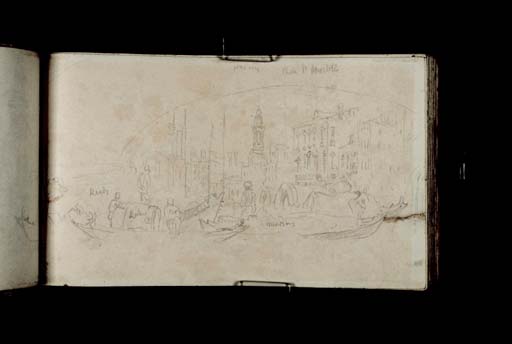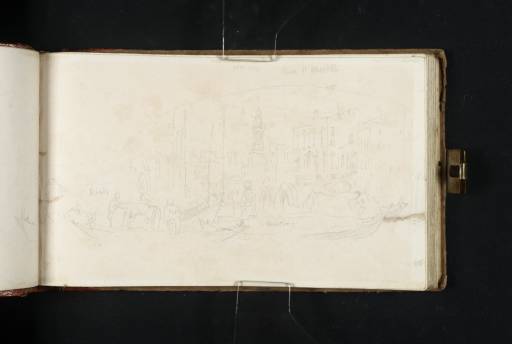Joseph Mallord William Turner The Grand Canal, Venice, from under the Rialto Bridge, with the Campanile of Santi Apostoli in the Distance 1819
Image 1 of 2
-
 Joseph Mallord William Turner, The Grand Canal, Venice, from under the Rialto Bridge, with the Campanile of Santi Apostoli in the Distance 1819
Joseph Mallord William Turner, The Grand Canal, Venice, from under the Rialto Bridge, with the Campanile of Santi Apostoli in the Distance 1819 -
 Joseph Mallord William Turner, The Grand Canal, Venice, from under the Rialto Bridge, with the Campanile of Santi Apostoli in the Distance 1819 (Enhanced image)Enhanced image
Joseph Mallord William Turner, The Grand Canal, Venice, from under the Rialto Bridge, with the Campanile of Santi Apostoli in the Distance 1819 (Enhanced image)Enhanced image
Joseph Mallord William Turner,
The Grand Canal, Venice, from under the Rialto Bridge, with the Campanile of Santi Apostoli in the Distance
1819
Joseph Mallord William Turner 1775–1851
Folio 81 Verso:
The Grand Canal, Venice, from under the Rialto Bridge, with the Campanile of Santi Apostoli in the Distance 1819
D14471
Turner Bequest CLXXV 81a
Turner Bequest CLXXV 81a
Pencil on white wove paper, 112 x 185 mm
Inscribed by Turner in pencil ‘Chisa St Apostoli’ towards top right, ‘Re[...]’, ‘Blue’, ‘[?Darker]’, ‘Y’ and ‘Br’ towards bottom left, on and around figures and boats, and ‘m[...]’ and ‘R B | W’ towards bottom right, on boat
Partial watermark ‘lee | 13’
Inscribed by Turner in pencil ‘Chisa St Apostoli’ towards top right, ‘Re[...]’, ‘Blue’, ‘[?Darker]’, ‘Y’ and ‘Br’ towards bottom left, on and around figures and boats, and ‘m[...]’ and ‘R B | W’ towards bottom right, on boat
Partial watermark ‘lee | 13’
Accepted by the nation as part of the Turner Bequest 1856
References
1909
A.J. Finberg, A Complete Inventory of the Drawings of the Turner Bequest, London 1909, vol.I, p.515, CLXXV 81 [sic], as ‘View on the Grand Canal near the “Chiesa SS. Apostoli”. Page 81 is reverse of Exhibited drawing, No.602i, N.G.’.
1930
A.J. Finberg, In Venice with Turner, London 1930, p.166, as ‘p. 81a, 82. Group of boats, etc. “Chiesa St. Apostoli.”’.
1984
Martin Butlin and Evelyn Joll, The Paintings of J.M.W. Turner, revised ed., New Haven and London 1984, p.152 under no.245.
2012
Niamh Mac Nally in Anne Hodge and Mac Nally, The Works of J.M.W. Turner at the National Gallery of Ireland, Dublin 2012, fig.45, as ‘Looking up the Grand Canal, to the North, from under the Rialto Bridge’.
Inverted relative to the sketchbook’s foliation, the view is from under the arch of the Rialto Bridge, looking north as the Grand Canal bends out of sight beyond the Palazzo dei Camerlenghi on the left. At the centre is the campanile of Santi Apostoli, and the most prominent building to its right is the Palazzo Crivan. There is a brief continuation of one of the boats in the foreground on folio 82 recto opposite (D14472). Compare the view from just north of the bridge on folio 75 verso (D14459).
When this leaf was rebound and stamped after being displayed in the nineteenth century, Finberg’s 1909 Inventory sequence, clear from his descriptive titles for the recto and verso, was disrupted. What is now the recto (D14470) was, by the implication of an ‘a’ suffix in his Inventory, the verso in his estimation, but it has since been bound as the recto and stamped as ‘81’; by its subject and more light-affected condition, it was evidently the exhibited side. For a discussion of the twelve leaves removed and restored in this way, see the technical notes in the sketchbook’s Introduction.
Reflecting confusion as to which side of this leaf was shown in early National Gallery displays, Finberg subsequently annotated his 1909 Inventory entry by crossing out parts of it, as follows: ‘80a | 81.} View on the Grand Canal near the “Chiesa SS. Apostoli”. Page 81 is reverse of Exhibited drawing, No.602i, N.G.’ 1 The Turner scholar C.F. Bell annotated these entries in another copy: ‘really the entrance to the Rio di Santi Apostoli opposite the Erberia’;2 the significance of his further note around this point in Finberg’s text, ‘from the canal opposite the Pescheria, looking N.W.’,3 is unclear, as it does not accurately describe any of the adjacent views.
Although Martin Butlin related the overall view to the very large but unfinished painting The Rialto, Venice of about 1820 (Tate N05543),4 it shows a prospect under the bridge looking in the opposite direction based on the drawing on folios 80 verso–81 recto (D14469–D14470), and is discussed under those pages.
For other drawings made in the vicinity and an overview of Turner’s coverage of Venice, see the sketchbook’s Introduction.
Matthew Imms
March 2017
How to cite
Matthew Imms, ‘The Grand Canal, Venice, from under the Rialto Bridge, with the Campanile of Santi Apostoli in the Distance 1819 by Joseph Mallord William Turner’, catalogue entry, March 2017, in David Blayney Brown (ed.), J.M.W. Turner: Sketchbooks, Drawings and Watercolours, Tate Research Publication, July 2017, https://www

